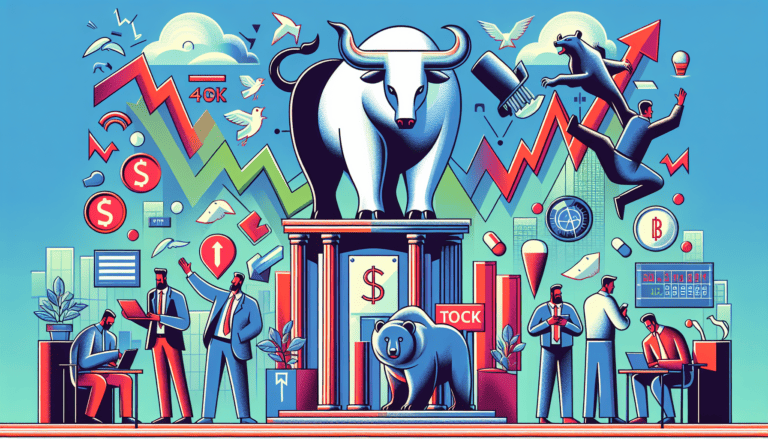Unlocking the Power of ETFs: Exploring Exchange-Traded Funds in Stock Markets

Understanding ETFs
Exchange-Traded Funds (ETFs) have become a cornerstone in the portfolios of many investors, from the novice to the experienced. They offer a blend of traits from various investment vehicles, making them a versatile choice for those participating in stock markets and exchanges.
ETFs Explained
An ETF, or Exchange-Traded Fund, is an investment fund that is traded on stock exchanges, much like individual stocks. Each ETF holds a collection of assets and is designed to track the performance of a specific index, sector, commodity, or asset class. Unlike mutual funds, which are priced at the end of the trading day, ETFs can be bought or sold at market prices throughout the trading day, providing greater flexibility for investors (source).
Investors favor ETFs for their diversification benefits, as a single ETF can provide exposure to a swath of assets, including but not limited to stocks, bonds, commodities, and currencies. This ability allows investors to build a diversified portfolio with just a single investment, streamlining the investment process and potentially reducing risk. Furthermore, ETFs are known for their transparency, as the holdings are typically disclosed on a daily basis.
Types of ETFs
ETFs are not a one-size-fits-all product; they come in various types, each catering to different investment strategies and goals. Here are some common categories of ETFs:
- Index ETFs: These ETFs aim to replicate the performance of a specific index, such as the S&P 500 or the Nasdaq.
- Sector and Industry ETFs: These funds target specific sectors of the economy, such as technology, healthcare, or energy.
- Commodity ETFs: These ETFs invest in physical commodities like gold or oil.
- Bond ETFs: These funds invest in various types of bonds, from government to corporate bonds.
- International ETFs: These ETFs provide exposure to markets outside of the investor’s home country.
- Thematic ETFs: These are designed around a particular theme or trend, such as environmental sustainability or emerging technologies.
ETFs are structured as open-ended investment companies or unit investment trusts and are regulated by the Securities and Exchange Commission (SEC), ensuring compliance with investment regulations and protection for investors (source).
The growing popularity of ETFs is a testament to their appeal. They offer low costs, tax efficiency, and ease of trading, characteristics that have made them a popular choice for both individual and institutional investors. For more foundational knowledge about financial markets, consider exploring understanding stock exchanges and major global stock exchanges.
Given the range of ETFs available, investors have the flexibility to tailor their investment strategies to their specific financial goals, risk tolerance, and market outlook. Whether looking to invest in broad market indices or niche sectors, ETFs in stock markets provide a vehicle for both diversification and targeted investment.
ETFs in the Market
Exchange-Traded Funds (ETFs) have become a staple in the financial markets due to their various attractive features. They appeal to a wide range of investors, from individuals just beginning their investment journey to seasoned institutional investors.
Popularity and Growth
ETFs have seen a meteoric rise in popularity among investors, primarily because of their low costs, tax efficiency, and ease of trading. These funds have become an important tool for both personal finance and institutional investment strategies. As a testament to their growth, the number of ETFs has soared to more than 6,300 globally, with a market capitalization nearing $9.5 trillion as of January 2022. This is a significant leap from the end of 2020, which saw around 5,500 ETFs with a global market cap of $6.8 trillion (source).
The table below illustrates the growth of ETFs in recent years:
| Year | Number of ETFs | Global Market Cap |
|---|---|---|
| 2020 | ~5,500 | $6.8 trillion |
| 2022 | >6,300 | $9.5 trillion |
ETFs are traded on major stock exchanges, making them easily accessible to a broad audience of investors. This accessibility is a key factor in the widespread adoption of ETFs in investment portfolios.
Regulatory Environment
The regulatory environment for ETFs is designed to protect investors while fostering a fair and transparent market. ETFs are subject to the regulations of the stock exchanges on which they are traded, and they must comply with specific requirements set forth by financial authorities.
In the United States, the Securities and Exchange Commission (SEC) oversees ETFs’ compliance with federal securities laws. The regulatory framework ensures that ETFs provide transparency, with their holdings disclosed daily, allowing investors to see exactly what assets they own (source). This level of transparency is part of what makes ETFs a trusted option for investors.
The regulatory landscape is continually evolving to adapt to new market developments and innovations within the ETF space. Stock market regulation and oversight play a crucial role in maintaining the integrity and efficiency of markets, ensuring that ETFs continue to be a viable and secure option for investors.
ETFs stand as a testament to the innovative and dynamic nature of modern financial markets, offering investors a flexible and efficient means of participating in a wide array of asset classes. As the market for ETFs continues to expand, understanding their role and regulatory environment is essential for anyone looking to dive into exchange-traded funds (etfs) in stock markets.
Advantages of ETFs
Exchange-traded funds (ETFs) have become increasingly popular in the stock markets due to their numerous benefits for investors, particularly for those who are just beginning to navigate the intricacies of understanding stock exchanges and the wider financial markets. Below are the primary advantages that ETFs offer.
Diversification Benefits
One of the principal advantages of ETFs is the diversification they provide. By holding a basket of securities, ETFs reduce the risk associated with investing in individual stocks. This is particularly beneficial for beginner investors who may not have extensive knowledge of stock market analysis techniques or the mechanics of stock trading. ETFs can offer exposure to a wide range of assets or sectors, from major global stock exchanges to specialized industries, which can buffer investors from the volatility of individual securities.
(Source)
Cost-Effectiveness
ETFs are typically more cost-effective than traditional mutual funds due to their lower expense ratios. Because ETFs are often passively managed and designed to track a specific index, such as the S&P 500, they incur fewer administrative fees. This cost-effectiveness makes ETFs an appealing choice for investors seeking to maximize their returns without incurring high costs.
(Investopedia)
Tax Efficiency
When it comes to taxes, ETFs generally offer more favorable treatment than mutual funds. The structure of ETFs allows for in-kind creation and redemption of shares, which minimizes the distribution of capital gains, thereby reducing the tax burden for investors. This tax efficiency is an important factor to consider, especially for those looking to maintain a long-term investing strategy.
(Time)
Trading Flexibility
ETFs boast a high level of trading flexibility. Unlike mutual funds, which price once at the end of the trading day, ETFs can be bought and sold throughout the trading day at market prices. This flexibility offers investors the ability to react quickly to market changes or to employ more advanced trading strategies, such as short selling or leveraged trading. Additionally, the transparency of ETFs, with their holdings typically disclosed daily, allows investors to make informed decisions.
(Investopedia)
In summary, ETFs in stock markets provide beginner investors with a blend of diversification, cost savings, tax advantages, and flexibility, making them a powerful tool for those looking to build a resilient investment portfolio. These benefits align well with various investment strategies, from portfolio diversification to tactical asset allocation, and underscore why ETFs are an essential component of modern investing.
How ETFs Work
Exchange-Traded Funds (ETFs) have revolutionized the way investors interact with the stock markets, offering a blend of benefits from both stocks and mutual funds. Understanding their functionality is critical for beginner investors looking to navigate the financial markets.
Tracking Performance
ETFs are investment vehicles designed to track the performance of a specific index, sector, commodity, or asset class. This tracking is achieved through a diversified portfolio of assets, mirroring the composition and performance of the target index. For instance, an ETF that tracks the S&P 500 will hold the same stocks in the same proportions as the S&P 500 index itself, aiming to replicate its returns as closely as possible.
| ETF Example | Index Tracked |
|---|---|
| SPDR S&P 500 ETF (SPY) | S&P 500 |
| iShares Russell 2000 ETF (IWM) | Russell 2000 |
| Vanguard Total Bond Market ETF (BND) | Bloomberg Barclays U.S. Aggregate Float Adjusted Index |
The performance of ETFs can be monitored in real-time throughout the trading day, allowing investors to stay informed about the value of their investment. More insights into tracking and performance can be found in our article on stock market indices explained.
Buying and Selling
Unlike mutual funds, which are priced once at the end of the trading day, ETFs are bought and sold throughout the trading day at market prices. This provides investors with the flexibility to react to market movements and execute trades at any time during market hours.
ETFs are traded on stock exchanges, similar to individual stocks, and can be purchased through a brokerage account. The process of buying and selling ETFs is akin to stock transactions, involving bids, asks, and market liquidity. For a deeper understanding of this process, refer to the mechanics of stock trading.
Liquidity and Transparency
One of the key advantages of ETFs is their high liquidity, meaning they can be easily bought and sold throughout the trading day. This liquidity is supported by the ability of large financial institutions to create or redeem ‘creation units’ of ETF shares, which helps to ensure that the trading price of an ETF remains close to its net asset value (NAV).
ETFs are also lauded for their transparency, as the composition of their underlying portfolio is typically disclosed daily. Investors can see exactly which assets they are exposed to and in what proportions. This level of transparency is beneficial for those who want to understand the exact makeup of their investments and is detailed in our exploration of electronic trading and its impact.
Understanding the mechanics behind ETFs is crucial for investors who wish to leverage their advantages in the stock market. From tracking the performance of diverse indices to enjoying the flexibility of trading and high liquidity, ETFs offer a range of features that can be integral to a successful investment strategy.
ETFs vs Other Investments
Exchange-Traded Funds (ETFs) have emerged as a popular investment vehicle in stock markets due to their unique characteristics. They offer investors a way to participate in the equity markets with a diversified approach. In this section, we will compare ETFs to stocks and mutual funds, which are traditional investment avenues.
ETFs and Stocks
Investing in stocks gives an investor part ownership in a company. Stocks are known for their potential for high returns, but they also come with higher risk and volatility. When comparing ETFs to individual stocks, the key differentiator is diversification. A single ETF can hold a basket of stocks, spreading out the risk across various companies and industries.
Additionally, while stocks can be bought and sold throughout the trading day on stock exchanges, they require investors to conduct thorough stock market analysis to make informed decisions. ETFs, on the other hand, provide an easier entry into the market without the need for in-depth analysis of individual stocks. They track various stock market indices, allowing investors to invest in the overall performance of a market segment.
| Investment Type | Trading Flexibility | Diversification | Potential for Returns | Risk Level |
|---|---|---|---|---|
| ETFs | High | High | Medium | Medium |
| Stocks | High | Low (per stock) | High | High |
ETFs and Mutual Funds
ETFs and mutual funds both offer diversification and professional management. However, they differ in several ways. ETFs can be traded like stocks, offering investors the ability to buy and sell shares during market hours at market prices. This provides a level of flexibility and liquidity that mutual funds do not typically offer, as mutual funds are traded only once per day after the market closes at the Net Asset Value (NAV) (Investopedia).
Another significant difference is in cost structure. ETFs are often passively managed and aim to replicate the performance of an index, so they generally have lower expense ratios than actively managed mutual funds. This cost-effectiveness is one of the main reasons ETFs are considered an attractive option for cost-conscious investors (Investopedia).
| Investment Type | Trading Time | Management Style | Expense Ratio | Tax Efficiency |
|---|---|---|---|---|
| ETFs | Throughout the trading day | Mostly passive | Lower | Higher |
| Mutual Funds | End of the trading day | Active/passive | Higher | Lower |
Investors looking to build a diversified portfolio might consider ETFs for their lower costs and flexibility. Meanwhile, those who prefer a more hands-off approach and do not mind paying a premium for potentially higher returns and professional management might find mutual funds more suitable.
In conclusion, ETFs offer a blend of the advantages of stocks and mutual funds. They provide diversification and lower costs like mutual funds while offering the trading flexibility and tax efficiency typically associated with stocks. Understanding these differences can help investors make more informed decisions when exploring exchange-traded funds (etfs) in stock markets and selecting the right investment vehicle for their financial goals.
ETF Investment Strategies
When it comes to investing in exchange-traded funds (ETFs) in stock markets, there are several strategies that investors can employ to meet their financial goals. ETFs offer a blend of diversification, cost-efficiency, and flexibility, making them a valuable tool for both novice and seasoned investors.
Portfolio Diversification
Diversifying one’s investment portfolio is a fundamental strategy to manage risk and enhance returns over the long term. ETFs are particularly well-suited for diversification due to their structure, which can include a wide array of assets within a single fund.
By investing in ETFs, individuals can gain exposure to various sectors, geographical regions, or asset classes. For example, one can invest in a broad-based ETF that tracks a stock market index, or in sector-specific ETFs that focus on industries like technology, healthcare, or energy. This approach helps to spread risk across different investments, reducing the impact of volatility in any single asset.
| ETF Type | Diversification Level |
|---|---|
| Broad-based Index ETF | High |
| Sector-specific ETF | Medium |
| Commodity ETF | Specific |
ETFs also offer diversification across different types of assets, including stocks, bonds, commodities, and currencies, providing a comprehensive investment solution for portfolio diversification (Investopedia).
Tactical Asset Allocation
Tactical asset allocation is a dynamic investment strategy that involves adjusting the asset allocation in a portfolio to capitalize on market opportunities or mitigate potential risks. ETFs are an efficient vehicle for this strategy due to their liquidity and ease of trading.
Investors can use ETFs to quickly shift their portfolio’s weightings among different asset classes, such as from equities to fixed income, in response to changing economic conditions or market forecasts. This flexibility allows investors to be more agile in their investment approach, taking advantage of short-term market movements without the need to buy or sell individual securities.
Long-Term Investing
For those seeking to build wealth over an extended period, ETFs are a compelling option for long-term investing. They offer a cost-effective way to invest in a diversified basket of securities, which is crucial for long-term growth.
Long-term investors can benefit from the lower expense ratios typically associated with ETFs compared to actively managed funds. Additionally, the transparency of ETFs allows investors to maintain a clear understanding of where their funds are allocated, supporting informed decision-making over time (Investopedia).
Investors can adopt a buy-and-hold strategy with ETFs that track well-established indices, which historically have tended to grow over time. This passive investment approach minimizes the costs and effort associated with frequent trading, allowing for potential compounding of returns.
By leveraging these strategies, investors can tap into the full potential of ETFs to achieve portfolio diversification, adapt to market changes with tactical asset allocation, and build wealth through long-term investing. Additionally, exploring educational resources like the mechanics of stock trading and market capitalization and its importance can further enhance one’s investment acumen.





